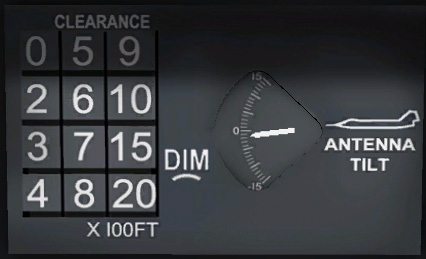
| MODE | EFFECTIVE AZ BEAM WIDTH |
ELEVATION BEAM WIDTH |
| GMP | 2.2 deg | 6.2 deg |
| GMS | 2.2 deg | Approx. 57 deg |

| Modes Applicable | |||||||
| Control or Indicator | Normal Position |
STBY | A/A | GMP | GMS | GME | Function |
| MODE SELECT Switch | OFF | X | X | X | X | X | Applies primary power to the APG-502 radar set; selects the desired mode of operation. |
| RANGE SWEEP Switch | 20 | X | X | X | X | Selects the range in miles that the range sweep on the indicator face will represent. The range selected is shown by the RANGE light on the radar indicator control panel. The 10 mile range is selected by operating the action reject button on the control stick with the RANGE SWEEP set at 20. In A/A selection of 80 gives 10 mile sweep. The action reject button is configurable in the Plugins-CF-104 Systems-Joystick Setup menu in X-Plane. | |
| ALT SET and RANGE GATE control | Detent | X | X | X | X | Not yet implemented in X-Plane. GMP, GMS, and GME modes: When adjusted so that ground targets begin to appear at the apex of the radar indicator, targets are displayed at the ground range. A/A mode: Detent for visual acquistion, out of detent for blind acquistion. | |
| ANT TILT Control | Centre | X | X | X | X | Tilts the antenna up or down. The amount of tilt in degrees is shown by the antenna tilt indicator on the clearance plane and antenna tile indicator panel to the right of the radar display. In X-Plane, this control can be programmed to a wheel on your stick or can be controlled from the key command menu. The dial in the virtual cockpit is inactive. The Plugins-CF-104 Systems-Joystick Setup menu in X-Plane can be used to associate the antenna tilt function with a joystick wheel. | |
| IF GAIN Control | Full INCR | X | X | X | X | Not implemented in X-Plane. | |
| RES SEARCH SWITCH | X | X | X | X | Not implemented in X-Plane. | ||
| Panel Lights | N/A | X | X | X | X | X | Light panel indicating radar mode active. |







